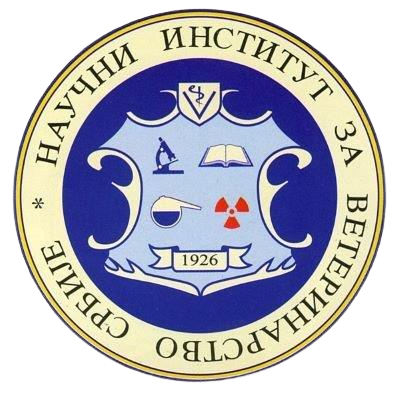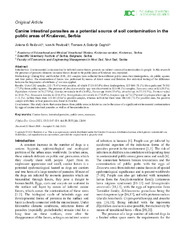Приказ основних података о документу
Canine intestinal parasites as a potential source of soil contamination in the public areas of Krusevac, Serbia
| dc.creator | Raicević, Jelena G. | |
| dc.creator | Pavlović, Ivan | |
| dc.creator | Galonja-Coghill, Tamara A. | |
| dc.date.accessioned | 2023-04-19T12:24:04Z | |
| dc.date.available | 2023-04-19T12:24:04Z | |
| dc.date.issued | 2021 | |
| dc.identifier.issn | 1972-2680 | |
| dc.identifier.uri | https://reponivs.nivs.rs/handle/123456789/465 | |
| dc.description.abstract | Introduction: Environmental contamination by infected canine faeces presents an indirect source of contamination in people. In this research the presence of parasitic elements in canine faeces found in the public areas of Krusevac was examined. Methodology: During May and October 2018, 282 samples were collected from different public areas (ten kindergartens, six public squares and four parks). The examination of faeces was performed by means of direct smear and flotation. For statistical testing of the difference between the frequencies of attributes chi(2) test was applied. Results: Out of 282 samples, 221 (78.4%) were positive, of which 17/20 (85.0%) from kindergartens, 125/160 (78.1%) from parks and 79/102 (77.5%) from public squares. The presence of Ancylostomatidae spp. was discovered in 113 (40.1%) samples, Toxocara canis in 82 (29.1%), Dipylidium caninum in 76 (27.0%), Giardia intestinalis in 45 (16.0%), Taenia spp. in 44 (15.6%), Amoeba spp. in 32 (11.3%), Trichuris vulpis in 19 (6.7%), Toxascaris leonina in 18 (6.4%), Strongyloides stercoralis in 17 (6.0%), Isospora spp. in 7 (2.5%) and Cryptosporidium spp. in 3 (1.1%). In May there were 115/141 (81.6%) positive samples, whereas in October there were 106/141 (72.5%) positive ones. No positive sample with three or four parasites was found in October. Conclusions: This study shows that canine faeces from public areas in Krusevac can be the cause of a significant environmental contamination by eggs of canine intestinal parasites as well as of human infections. | en |
| dc.publisher | J Infection Developing Countries, Tramaniglio | |
| dc.rights | openAccess | |
| dc.rights.uri | https://creativecommons.org/licenses/by/4.0/ | |
| dc.source | Journal of Infection in Developing Countries | |
| dc.subject | zoonoses | en |
| dc.subject | public areas | en |
| dc.subject | intestinal parasites | en |
| dc.subject | Canine faeces | en |
| dc.title | Canine intestinal parasites as a potential source of soil contamination in the public areas of Krusevac, Serbia | en |
| dc.type | article | |
| dc.rights.license | BY | |
| dc.citation.epage | 154 | |
| dc.citation.issue | 1 | |
| dc.citation.other | 15(1): 147-154 | |
| dc.citation.rank | M23 | |
| dc.citation.spage | 147 | |
| dc.citation.volume | 15 | |
| dc.identifier.doi | 10.3855/jidc.12694 | |
| dc.identifier.fulltext | http://reponivs.nivs.rs/bitstream/id/317/462.pdf | |
| dc.identifier.pmid | 33571157 | |
| dc.identifier.rcub | conv_559 | |
| dc.identifier.scopus | 2-s2.0-85101376391 | |
| dc.identifier.wos | 000619515400017 | |
| dc.type.version | publishedVersion |

